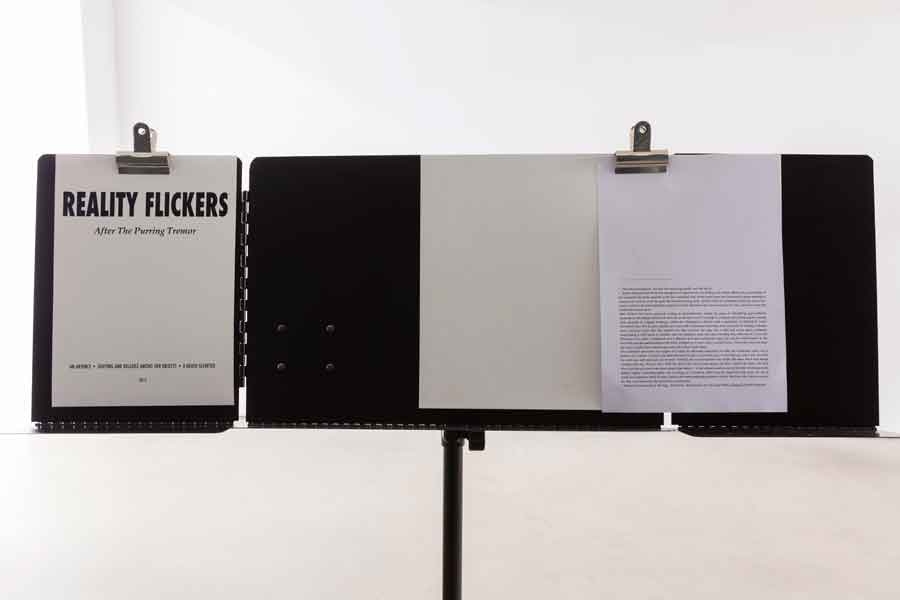Reality Flickers, or ‘Miss Reality’, is one of two characters in the recited, recorded short story one hears, in Katrina Palmer’s first solo show, after walking into a grey steel locker less than two metres square. But nothing is stable in the textual-sculptural cosmoses constructed by Palmer – a slow-burning, serious, formally unique artist in her mid-forties, selected by Elizabeth Price last year as an ArtReview FutureGreat – and so ‘reality’, here, is also that which we know it as: what we believe, for now, to be real. That flickers too.
Sit down on a metal chair and Palmer’s English voice, processed to sound thin and hollow and variably laced with reverb, recounts a brief, grim, surreal revenge narrative. Miss Reality is a skip-scavenger, perhaps an artist – “she had recently been inquiring into the unstable matter of reality, a greater understanding of material contingencies was the very thing she pursued” – and one of her finds, we’re given to surmise, was this very locker. Stumbling out of a skip one day, Reality meets the Heart Beast, who, muttered double-tracked voices suggest, is a “fucker” and a “trickster”, a master of facades. They go back to her place; he wins her affection by looking at her work, “an open vein that led directly into her bloodstream”. As they clinch, she is “deep in the fantasy that his eyeballs could be extracted and added to her collection”. Cue a brief, pointedly Bataille-like conflation of erotics and optics: the subject of eyeballs and their removal, of course, also addresses seeing and not seeing.
Sit down on a metal chair and Palmer’s English voice, processed to sound thin and hollow and variably laced with reverb, recounts a brief, grim, surreal revenge narrative.
The Heart Beast only wants Reality’s body, and when it’s all over she realises as much. Furious, she stabs him through the neck with “the anodised handle from a shattered glass door”: picture it corkscrewing glassily through vocal cords. And so this is a story about reprisal, but also sculpture and form. The narrative, in its diverting extremity, is a roughhousing form of dematerialised sculpting, manifesting skips and eyeballs and door handles and bodies in the mind’s eye; and in this sense the artist Palmer appears closest to is Lawrence Weiner, who views his own texts as sculpture. But Weiner’s work is a relatively closed and propositional system. Palmer’s is phenomenological, with intentionally ragged edges that create a frictional anxiety, and feels to be going somewhere outside of mere structural inquiries.
In the course of Reality Flickers, clearly, words become objects, sentient people become bodies/receptacles, objets trouvés in the gallery have supposedly emerged from a fiction, men are not what they appear to be and the nervy Miss Reality turns quickly murderous in her frustration at deceptive surfaces. All of this could be neutered if we arrange things in one particular order: that the narrative is an attention-getting metaphor for appearances per se, ‘appearances’ and their unreliability being a piety of contemporary art. Yet that short-sells Palmer’s specific, gendered focus.
The extremist storytelling tradition she comes out of includes the writings of William Burroughs and Kathy Acker as well as the Cinema of Transgression: this is updated punk provocation, in other words, constructing a nightmarish fantasy-space that’s a distorted magnification and upending of actual male/ female power relations – and noting, not irrelevantly, that such things still need saying. Such writing, of course, now finds a fragile sanctuary in the artworld. Outside of its chambered viscerality, though, the latent thrill of Palmer’s show is that it presents her not as an experimental writer looking to recontextualise herself, but as someone who recognises that writing, to earn its keep here, ought to speak – in order to modify – art’s language.
Originally published in the March 2014 issue
